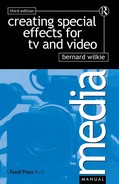Bullet Effects In Glass and Mirrors
Bullets fired at glass should ideally produce holes surrounded by a number of radiating cracks giving a roughly circular, fist-sized area of destruction. Without this surrounding area of damage, bullet holes appear unconvincing.
Bullet effect by editing
Dramatic effects can be obtained by painting simulated bullet holes on cut-out pieces of self-adhesive clear plastic sheet. When the scene is filmed these cut-outs are applied in sequence to the glass and the resultant film edited to show the holes appearing one after another. With post-dubbed sound-effects this is an economical way of achieving results.
Capsule gun
This device (described on page 122) can produce realistic effects, again, without actual damage to the glass. This is useful where automobiles are required to have their windshields shot at.
Gelatine capsules filled with petroleum jelly are fired at the glass with sufficient force to rupture the capsule and spread the jelly across the surface. The capsules may have small black discs and pieces of tin foil added to their filling. The theory is that the black disc resembles the hole and the foil will give a better shatter effect on the glass, but success is a matter of chance.
Shatter glass
Ordinary glass may be treated to provide dramatic bullet holes but in this case, unlike the effects described above, the glass is actually smashed by the impact.
A sheet of clear, self-adhesive plastic (of the type used to cover pictures or books) is applied to a sheet of thin window glass. This must be done carefully to ensure that air bubbles are not trapped between the two materials.
Mirrors may be similarly treated, but the plastic sheet in this instance need not be clear.
To produce the bullet holes in glass treated in this fashion it is necessary to fire a projectile right through it. The capsule gun, this time loaded with steel slugs, produces an admirable effect.
A mirror can appear to be shattered by a bullet if a captive, spring-loaded bolt is released from behind. Few splinters of glass escape from the adhesive backing, but if an actor is close to the mirror, it should be fronted with a protective sheet of acrylic plastic.
BULLET EXPLOSIONS IN GLASS AND MIRRORS
1. Mechanical method
A spring-loaded door closer can be used to smash a mirror from behind.
2. Explosive method
A mirror can be shattered by placing a bullet-hit behind it and covering the spot with a chunk of modelling clay. This method must not be used close to actors as small fragments of glass are projected with considerable force.
3. Improving the effect
Mirrors or sheets of glass that are shot at with metal projectiles (including the spring arm) will break disappointingly (left) unless they are covered at the back with adhesive plastic sheet. This produces a much more satisfactory visual effect (right).

